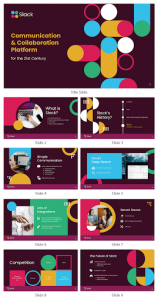If you are thinking of launching your own graphic design business, then you must build pitch deck examples for your graphic design portfolio. The pitch deck examples for your graphic design portfolio will demonstrate your capabilities to potential clients or to anybody who might want to know more about what you do.
What is a pitch deck? A pitch deck is a very brief, visually oriented summary of your business or company that explains what you do and why you are unique. As such, it is important to create a compelling visual representation of the business that will be displayed throughout your website. For this reason, you must have an exceptional graphic design portfolio that you can use as a template for your pitch deck.
Graphic design is essentially the process of combining images and text to convey a certain message or information. Graphic designers typically work with numerous designs such as logos, advertisements, magazines, brochures, booklets, and portfolios among many others. The majority of graphic design jobs are not confined to one specific industry. A graphic design resume can be used to build a professional and quality CV.
What to Look For In A Pitch Deck Template for Graphic Design Portfolio?
As mentioned earlier, you must choose an exceptional graphic design portfolio as the template for your own business. An exceptional graphic design portfolio will not only be able to stand on its own but will also create an impact with any audience.

For this reason, you must pay attention to the following important elements when choosing your template:
1) Portfolio Purpose In The Business Pitch Example
Your first step should be figuring out what kind of graphic design portfolio you need. Do you need an e-portfolio, a print portfolio or to showcase your work online? Depending on the purpose of your graphic design business and how it will be marketed, consider which portfolio is best suited for your business needs.
You may want to include your white paper along with your portfolio, which you can easily create on Venngage.
2) Portfolio Contents In The Presentation Deck
Think about what kind of message should be conveyed to your audience and which type of rest will be best at conveying that kind of message. Will you need to create layouts or animations? Are there certain kinds of fonts and colors that should be used as part of the design? All these factors will come into play when creating your graphic design portfolio.
3) Search Engine Optimization (SEO)
Always make sure that your portfolio template is SEO-friendly. This means that it should be optimized to make your business easily searchable on the internet and by search engines such as Google.
4) Ease of Use of the Slide Deck Templates
It should be easy for you to use your portfolio templates and make minor adjustments when necessary. By doing this, it will allow you to have a greater degree of flexibility when building your business.
5) Customization Options
Depending on the features of your template, you should always be able to customize it without having too many problems. Make sure that certain customization options allow you to make minor changes if necessary.
Venngage
6) Portfolio Reviews and Testimonials
It is important to show your existing clients or employers that you have done excellent work for them in the past. For this reason, you need to choose your templates wisely so that they can provide proof of your skills and experience.
7) Presentation Effortlessness
If a potential client were to look at your graphic design portfolio, then he or she should be able to do so without too many problems. You should be able to provide them with a presentation of your work most easily and conveniently possible.
8) Budget Friendly
You need to keep an eye on your budget when creating your portfolio templates. By doing this, it will allow you to create a more cost-effective business.
9) Portfolio Versatility
You should always look for a graphic design portfolio that can be customized to match any company’s needs and requirements. It is also important that the graphics, text styles, and general positioning of elements can be changed or altered as necessary by your clients or employers.
10) Media Types Supported
You need to make sure that your business template supports the media types and web formats on which you wish to focus. For this reason, it is important to figure out first which media types and web formats will work best for your specific business needs.
11) Portfolio File Format
To maintain consistency in the look of your portfolio, it is important to choose a file format that is easily editable so that you can make minor adjustments when needed.
Bottomline
Once you have considered the above factors, it is time to choose a graphic design portfolio template that will work best for your business needs. When doing so, make sure that they can accommodate any additional features and functionalities as well as support all your media needs as well as web formats. To create a graphic design portfolio that truly stands out from the competition, then you will have to do some research and analysis of your specific business needs. This means that your business template should convey a message of professionalism and creativity at all times while also being suitable for search engine optimization purposes. This way, it can make your business more easily searchable on the internet and by major search engines such as Google.













